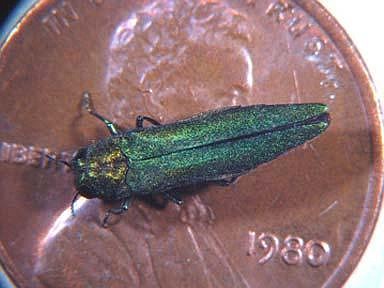Foresters with the Missouri Department of Conservation, in conjunction with the Missouri and U.S. departments of agriculture, have confirmed the presence of emerald ash borer in Cole and Callaway counties along with nine other counties in Missouri.
Since EAB was first detected in Missouri in July 2008, the exotic, tree-killing pest has spread to a total of 53 Missouri counties and the City of St. Louis, according to an MDC news release.
It was found in Miller and Maries counties earlier this year. MDC also confirmed Thursday it had been found in Adair, Cape Girardeau, Greene, Jefferson, Lewis, Lincoln, Pike, Polk and Warren counties.
EAB is a small, metallic green beetle native to Asia that attacks all species of ash trees. At approximately a half-inch long, the green adult beetle feeds on leaves and does little damage to trees. However, in its larval stage, the insect kills ash trees by feeding on the water- and nutrient-conducting tissues just under the bark.
Because EAB kills more than 99 percent of the ash trees it attacks within three to four years of infestation, MDC Forest Entomologist Robbie Doerhoff urges people who own ash trees in areas where EAB has been found to either treat or remove those trees.
"If you have a healthy, high-value ash tree in your yard, it can be treated with insecticides, but these treatments must be applied every year or two to guarantee protection," Doerhoff said. "For some ash trees, especially those that have already lost more than 50 percent of their leaves and branches, the best option is removal, followed by replanting with a different species, such as an oak native to Missouri."
Several insecticide treatment options are available, including some do-it-yourself methods, Doerhoff said. However, insecticides available at home improvement stores work best on trees smaller than 20 inches in trunk diameter (measured 4.5 feet from the ground). Trees larger than 20 inches in trunk diameter require insecticides available only to licensed applicators to provide adequate protection from EAB.
"If you decide to treat your ash tree, make sure you use a pesticide labeled to kill EAB and that you apply it at the right time of year," Doerhoff said in the news release. "Chemical treatments are most effective in early spring when a tree's vascular system is better able to take up the insecticide. In late summer, and especially during drought conditions like we're currently experiencing across most of Missouri, treatments may not work properly."
Now is a good time to develop a plan and, if appropriate, contact a professional to get on a list for a spring treatment, Doerhoff said. For large trees that need to be treated by a professional, use a reputable company and get a couple of bids. Some neighborhoods receive discounts if several people have ash trees treated by the same company.
MDC officials advised that after ash trees are removed they should be disposed of locally to prevent the accidental spread of EAB to new locations. EAB can emerge from ash firewood and logs for up to two years after harvest.
For more information on EAB, download the Emerald Ash Borer Management Guide for Missouri Homeowners at short.mdc.mo.gov/ZSq.
MDC encourages Missourians to learn to identify signs of EAB and report possible infestations in counties where the pest has not yet been confirmed. For a map of EAB's spread across Missouri and detailed information on identification, visit eab.missouri.edu. Report suspected EAB damage in new counties to a local MDC forester, call MDC's Forest Pest Hotline at 866-716-9974, or email [email protected].

